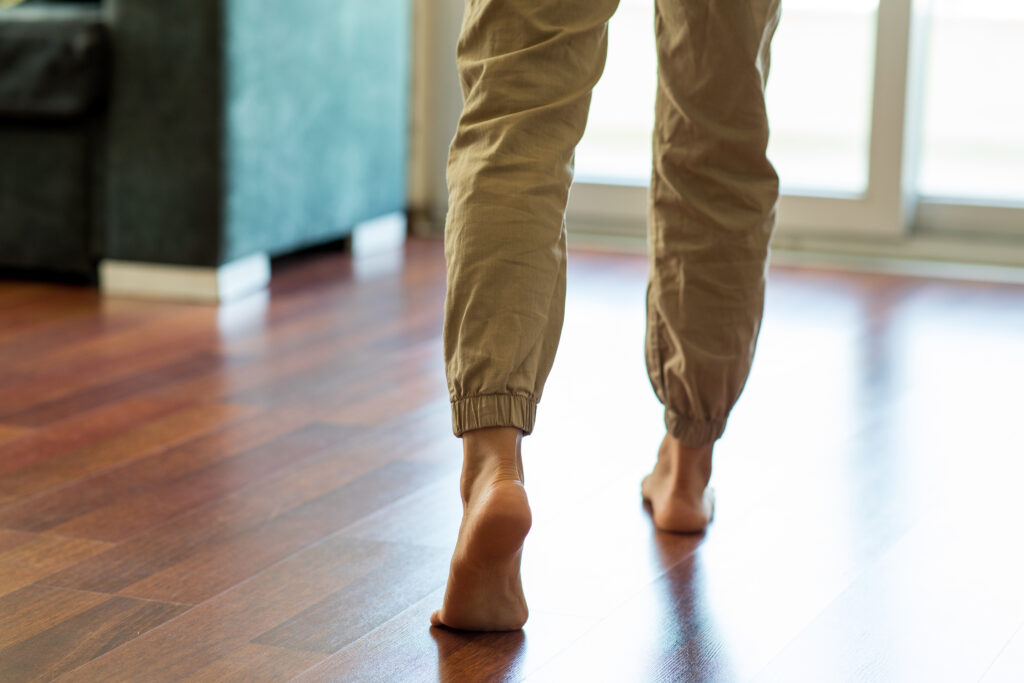Where It Hurts: My Foot or Ankle
Your feet and ankles are built to be amazingly strong, bearing as much as four times your weight with every step. They are also full of delicate structures—tiny bones, muscles, nerves, ligaments, and tendons. Overuse, traumatic injury, or just wearing certain types of shoes can cause foot or ankle pain. Learn more about conditions that affect feet and ankles, and how the specialists at Orthopedic Associates of Dutchess County can help.
Common Foot and Ankle Injuries and Conditions
We see patients with all types of foot and ankle pain, and the most common injuries and conditions we treat are:
- Achilles tendon injuries: Achilles tendons can become inflamed from overuse, causing pain and tenderness above the heel bone. There are many non-surgical ways to treat Achilles tendinitis. However, if the tendon ruptures (which causes sudden pain), it’s a more serious issue.
- Ankle pain: Ankles can hurt for many reasons, from overuse, tendinitis, or impingement (pain in the back of the ankle). If your ankle is swollen, has a limited range of motion, hurts to bend, and doesn’t improve after resting for a few days, see a doctor.
- Ankle sprains: A sprain is an injury to the ligament—when it gets stretched beyond what it can handle. This causes pain, swelling, bruising, and often, a feeling of instability in your ankle.
- Arthritis: Arthritis causes pain and swelling in your joints, such as your feet, toes, and ankles. Arthritis can happen over time as your cartilage wears out (osteoarthritis). But some people have rheumatoid arthritis (RA), an autoimmune condition that often affects the small joints of the feet.
- Bunions: A bunion is a swelling where your big toe connects to the foot. The joint can start to bulge out and become very painful. Wearing certain types of shoes can cause bunions, but they can also be genetic.
- Fractures and Trauma: Injuries to the foot and ankle, causing bone fractures or dislocations, occur frequently. Ankle and heel bone fractures often require surgical treatment, while others, such as toe injuries, do not require surgery but rather close monitoring.
- Hammertoe: Hammer toe, which affects the second, third, and fourth toes, can cause pain and make finding comfortable shoes difficult. Bunions, irregularity in toe length, or traumatic injury can also cause toe pain.
- Heel pain: Plantar fasciitis is one of the most common reasons for heel pain, usually hurting first thing in the morning. Achilles tendon issues can also cause heel pain, as can injuries to the nerves in your foot.
- Morton’s neuroma: Morton’s neuroma can cause a tingling, unpleasant feeling in your toes, or more severe pain in the ball of your foot. Some people describe it as feeling like there’s a pebble or tiny ball inside the ball of their foot.
- Stress fractures: Stress fractures, or tiny cracks in the bone, are most common in the bones of the foot. They usually get better with rest and often heal on their own. More serious fractures will cause more intense pain, which doesn’t necessarily improve with rest.
We see patients with all types of foot and ankle pain, and the most common injuries and conditions we treat are:
- Achilles tendon injuries: Achilles tendons can become inflamed from overuse, causing pain and tenderness above the heel bone. There are many non-surgical ways to treat Achilles tendinitis. However, if the tendon ruptures (which causes sudden pain), it’s a more serious issue.
- Ankle pain: Ankles can hurt for many reasons, from overuse, tendinitis, or impingement (pain in the back of the ankle). If your ankle is swollen, has a limited range of motion, hurts to bend, and doesn’t improve after resting for a few days, see a doctor.
- Ankle sprains: A sprain is an injury to the ligament—when it gets stretched beyond what it can handle. This causes pain, swelling, bruising, and often, a feeling of instability in your ankle.
- Arthritis: Arthritis causes pain and swelling in your joints, such as your feet, toes, and ankles. Arthritis can happen over time as your cartilage wears out (osteoarthritis). But some people have rheumatoid arthritis (RA), an autoimmune condition that often affects the small joints of the feet.
- Bunions: A bunion is a swelling where your big toe connects to the foot. The joint can start to bulge out and become very painful. Wearing certain types of shoes can cause bunions, but they can also be genetic.
- Fractures and Trauma: Injuries to the foot and ankle, causing bone fractures or dislocations, occur frequently. Ankle and heel bone fractures often require surgical treatment, while others, such as toe injuries, do not require surgery but rather close monitoring.
- Hammertoe: Hammer toe, which affects the second, third, and fourth toes, can cause pain and make finding comfortable shoes difficult. Bunions, irregularity in toe length, or traumatic injury can also cause toe pain.
- Heel pain: Plantar fasciitis is one of the most common reasons for heel pain, usually hurting first thing in the morning. Achilles tendon issues can also cause heel pain, as can injuries to the nerves in your foot.
- Morton’s neuroma: Morton’s neuroma can cause a tingling, unpleasant feeling in your toes, or more severe pain in the ball of your foot. Some people describe it as feeling like there’s a pebble or tiny ball inside the ball of their foot.
- Stress fractures: Stress fractures, or tiny cracks in the bone, are most common in the bones of the foot. They usually get better with rest and often heal on their own. More serious fractures will cause more intense pain, which doesn’t necessarily improve with rest.
Physicians

- Trauma and Fracture Care
- Spine
Practicing in:
Poughkeepsie and Hopewell Junction
- Foot and Ankle
Practicing in:
Poughkeepsie and Hopewell Junction
- Sports Medicine
Practicing in:
Poughkeepsie and Hopewell Junction
- Hip and Knee Replacement
- Sports Medicine
- Trauma and Fracture Care
Practicing in:
New Windsor
- Foot and Ankle
Practicing in:
Poughkeepsie, New Windsor, and Kingston
- Hip and Knee Replacement
- Trauma and Fracture Care
Practicing in:
Poughkeepsie, Rhinebeck, and Kingston
- Foot and Ankle
Practicing in:
Poughkeepsie, Rhinebeck, and Kingston
- Primary Care Sports Medicine
- Sports Medicine
Practicing in:
Poughkeepsie and Hopewell Junction


